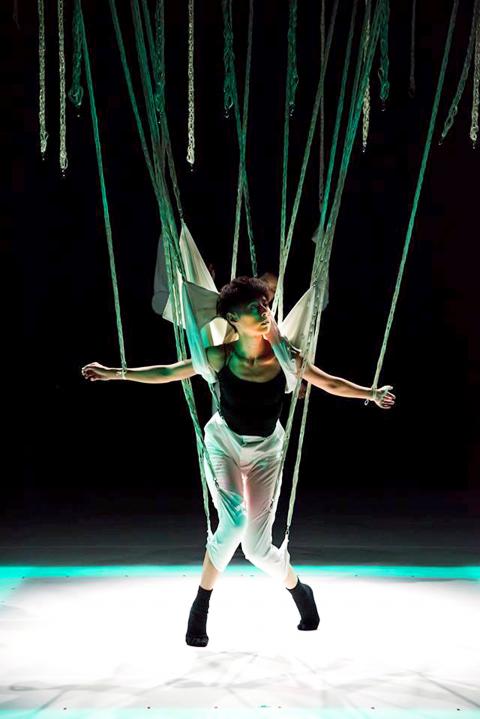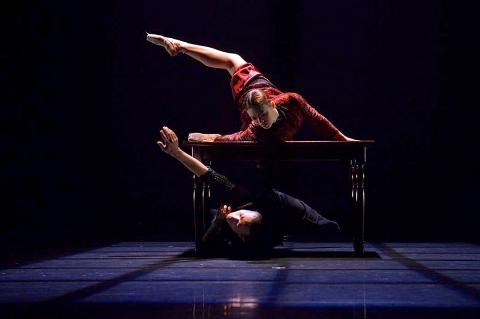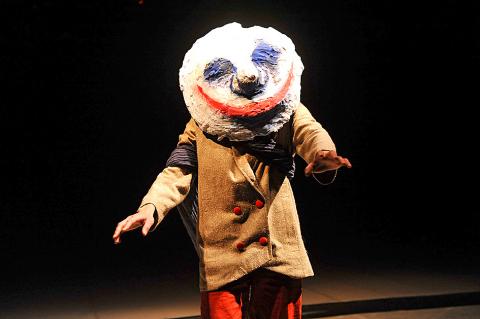Established choreographers and up-and-coming talent have been invited to showcase recent works, expanded versions of earlier dances and excerpts from longer works this weekend in Taipei as part of the 2019 CoDance (2019 相遇舞蹈節) production at Umay Theater.
The event, curated by Sun-Shier Dance Theatre (三 十舞蹈劇場) and Huashan 1914 Creative Park, follows on the success of CoDance in March last year, and will feature eight works spread over three different programs, each of which will be performed twice.
2019 CoDance opens tonight with the “Series C” show, featuring works by Lin Yi-jie (林依潔), Lai Hung-chung (賴翃中) and Luo Wen-jinn (羅文瑾), grouped under the theme of “arrived.”

Photo Courtesy of Wu Chen-hsuan
Former Sun-Shier dancer Lin Yi-jie, who has choreographed several works for the company, contributed Peng Ju Teng Syi (蹦.舉.騰.思), a 12-minute piece set on two dancers hanging in the air from bungee ropes. Lin was inspired to explore balance, gravity and freedom.
Lai’s Raining in The Room, which he originally choreographed for Kaohsiung City Ballet’s 2017 Dance Shoe (點子鞋) production, was set on two of his former university classmates, Cheng I-han (鄭伊涵) and Chien Lin-yi (簡麟懿), and could be considered a breakout work for all three.
Building on the success of that piece, Lai went on to choreograph other works on Cheng and Chien that won him awards at choreographic competitions in Europe and led him to establish his own troupe, Hung Dance (翃舞製作).

Photo courtesy of Liu Ren-haur
For 2019 Codance, he has revised Raining in The Room to reorient the axis of development from ballet to contemporary dance.
The third piece in Series C is an excerpt from Luo’s 2017 Abyss that she created for the Tainan-based Scarecrow Contemporary Dance Company (稻草人現代舞蹈團), where she is artistic director.
It was inspired by passages from German philosopher Friedrich Nietzsche’s Thus Spoke Zarathustra: The idea of mankind as rope stretched between the animal and the Superman — a rope over an abyss.

Photo courtesy of 2019 CoDance
The Series C program will be repeated on Saturday afternoon.
The “Series A” program, “cross-border friends,” will be performed tomorrow and Sunday nights, with works by Chang Kuo-wei (張國韋) and Lin Ting-hsu (林廷緒), while “Series B,” with a theme of survival and hidden rules, will be performed Saturday night and Sunday afternoon, and features dances by Chen Chao-chun (陳兆豊), Wang Yu-guang (王宇光) and Chang Hsiu-ping (張秀萍).
Chang Kuo-wei first came to my attention with his hiphop-influenced Alternate Realm (鏡界) for the Taipei National University of the Arts’ (TNUA) Dance Department winter concert in December 2016. Chang impressed again with his Rewind (彈一段過錯的日子) for the department’s concert in December last year. He was also chosen to be in the Newcomers (注目新人) section of last year’s CoDance program.
This time his piece, You Mei You (友沒友), is a 30-minute new street-dance flavored work set on three dancers that explores the ties and frictions of friendships, past and present, and the need to cherish such connections.
Lin Ting-hsu’s Ba Ba (八八) is also a half-hour, and is an expanded version of a 15-minute piece, The Body that Does Not Exist, which was presented at TNUA in November 2017 and also won a prize at the 14th Guangdong Modern Dance Week.
The four dancers will perform with musicians in the cross-disciplinary work, which tells a story of a land and the souls that reside there.
In “Series B,” Chen’s piece, the 15-minute Chien Kuei-tse (潛規則), has been expanded from an eight-minute work created for a dance competition in 2017.
Set on three dancers, it explores the many unwritten social rules placed upon us that subconsciously limit our actions and interactions.
Wang, a dancer with Cloud Gate 2 (雲門 2), has revised Wu Lian Woniu (無臉蝸牛), a 13-minute solo that premiered at the Chiayi County Performing Arts Center in June last year, and added two more minutes.
Wang was inspired by the traces left behind by snails as they crawl along a wall. The dance will be performed by Chen Hsin-yu (陳欣瑜), with a mask created by Hsu Chia-hsuan (許嘉軒).
The final work on the program is a new piece by SunShier cofounder Chang, titled Baiyan Fan Fan (白眼翻翻). The 30-minute work, set on eight of the company’s dancers, is a psychological exploration of our hearts, our eyes and our imagination.

The Directorate-General of Budget, Accounting and Statistics (DGBAS) told legislators last week that because the Chinese Nationalist Party (KMT) and Taiwan People’s Party (TPP) are continuing to block next year’s budget from passing, the nation could lose 1.5 percent of its GDP growth next year. According to the DGBAS report, officials presented to the legislature, the 2026 budget proposal includes NT$299.2 billion in funding for new projects and funding increases for various government functions. This funding only becomes available when the legislature approves it. The DGBAS estimates that every NT$10 billion in government money not spent shaves 0.05 percent off

Dec. 29 to Jan. 4 Like the Taoist Baode Temple (保德宮) featured in last week’s column, there’s little at first glance to suggest that Taipei’s Independence Presbyterian Church in Xinbeitou (自立長老會新北投教會) has Indigenous roots. One hint is a small sign on the facade reading “Ketagalan Presbyterian Mission Association” — Ketagalan being an collective term for the Pingpu (plains Indigenous) groups who once inhabited much of northern Taiwan. Inside, a display on the back wall introduces the congregation’s founder Pan Shui-tu (潘水土), a member of the Pingpu settlement of Kipatauw, and provides information about the Ketagalan and their early involvement with Christianity. Most

The People’s Republic of China (PRC) was out in force in the Taiwan Strait this week, threatening Taiwan with live-fire exercises, aircraft incursions and tedious claims to ownership. The reaction to the PRC’s blockade and decapitation strike exercises offer numerous lessons, if only we are willing to be taught. Reading the commentary on PRC behavior is like reading Bible interpretation across a range of Christian denominations: the text is recast to mean what the interpreter wants it to mean. Many PRC believers contended that the drills, obviously scheduled in advance, were aimed at the recent arms offer to Taiwan by the

It is a soulful folk song, filled with feeling and history: A love-stricken young man tells God about his hopes and dreams of happiness. Generations of Uighurs, the Turkic ethnic minority in China’s Xinjiang region, have played it at parties and weddings. But today, if they download it, play it or share it online, they risk ending up in prison. Besh pede, a popular Uighur folk ballad, is among dozens of Uighur-language songs that have been deemed “problematic” by Xinjiang authorities, according to a recording of a meeting held by police and other local officials in the historic city of Kashgar in